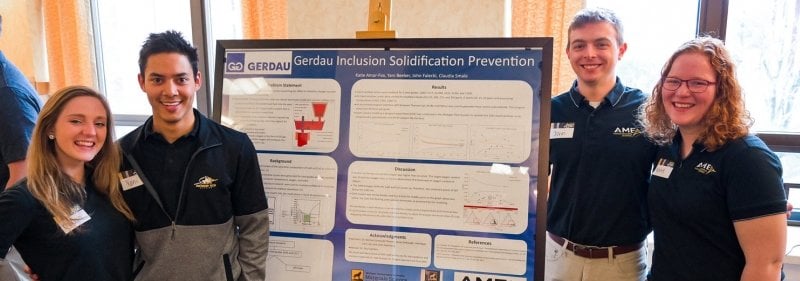Gerdau Inclusion Solidification Prevention
Third Place Senior Design Award
Team Members
Katie Amar-Fox, Yani Beeker, John Falecki, and Claudia Smale, Material Science and
Engineering
Advisor
Paul Sanders, Materials Science and Engineering
Sponsor
Gerdau—Monroe Mill
Project Overview
Our team is working with Gerdau to better understand how inclusion phases change as
alloy compositions change, temperature changes, and oxygen levels fluctuate. The objective
is to successfully model inclusions in molten steel at temperatures from 1,500°C to
1,600°C. Major goals include using thermodynamic modeling software data to create
an optimal composition where the inclusions are in a liquid state above the calcium
aluminate saturation line but below the calcium sulfide curves. The second phase is
validating the created model through an experimental design conducted in the foundry.
Cobalt Reduction in Tribaloy T-400
Team Members
Lucas Itcue, Kyle Hrubecky, Jacob Thompson, and Erin VanDusen, Material Science and
Engineering
Advisors
Paul Sanders and Walt Milligan, Materials Science and Engineering
Sponsor
Winsert Inc.
Project Overview
Winsert Inc., currently uses an alloy similar to Tribaloy T-400, a cobalt based alloy,
in the production of internal combustion engine valve seats. Cobalt is an expensive
element with a rapidly fluctuating price due to political instability in the primary
supplier country, the Democratic Republic of the Congo. As Tribaloy T-400 contains
approximately 60 wt. percent cobalt, it is a highly expensive alloy; therefore, decreasing
the amount of cobalt in T-400 is a direct way to reduce cost. Through thermodynamic
modeling, replacement of cobalt with other transition elements such as iron, nickel,
and aluminum will be investigated. Tribaloy T-400 contains a C14 Laves phase, with
a MgZn2 structure, and a cobalt solid solution with an FCC structure. The microstructure
includes the primary C14 Laves phase and eutectic microconstituent of C14 Laves phase
plus a cobalt solid solution. By volume, the C14 Laves phase accounts for 35-45 percent
of the microstructure. The C14 Laves phase provides much of the high temperature wear
resistance for the alloy, therefore, retaining a similar amount of this phase in new
alloys is paramount to maintaining mechanical and wear properties.
Nodule Reduction on Steel Reheat Furnace Refractory
Team Members
Eric Olson, Pat Ricchi , Matt Thomas, and Casey Vadnais, Material Science and Engineering
Advisor
Paul Sanders, Materials Science and Engineering
Sponsor
ArcelorMittal
Project Overview
The reaction between an alumina based refractory and wustite produces a hercynite
nodule on the hearth refractory, causing tears in steel slabs as they are pushed across
in the reheat furnace. An attempt to reduce pores acting as nucleation sites for nodule
growth was performed by utilizing a non-reactive and bondable coating on the hearth
refractory.
TRIP Steel Additive Manufacturing
Team Members
Mackenzie Keefer, Jacob Coulson and Rene Teufack, Material Science and Engineering;
Nate Stancroff, Mechanical Engineering
Advisor
Paul Sanders, Materials Science and Engineering
Sponsor
ArcelorMittal
Project Overview
Wire arc additive manufacturing (WAAM) was employed to produce multi-layer three dimensional
parts made from transformation induced plasticity (TRIP) steel. The process of drawing
and additive manufacturing TRIP steel was optimized. This process will make prototyping
more affordable, and introduce flexible deposition that could allow for structures
to be added onto pre-existing parts.
Laser Safety Proposal for Minerals and Materials Room 329
Team Members
Margaret Miko and Timothy Ingram, Mechanical Engineering Technology
Advisors
John Irwin, Department of Manufacturing and Mechanical Engineering Technology; Russell Stein, Paul Sanders, Materials Science and Engineering
Sponsor
Department of Materials Science and Engineering
Project Overview
Due to the presence of a new laser, there are increased risks and hazards introduced
to Michigan Tech, which results in the need for additional safety precautions and
equipment in order to isolate the laser beam, protect the operator, and protect bystanders.
Upon receiving the laser, there was a lack of information concerning the operation
and functionality of components, which will need to be assessed prior to implementation
of laser specific safety features.
Effects of Scandium on Cast Iron
Team Members
Katherine Russell, Mason Coy, and Erin Heidelberger, Material Science and Engineering
Advisor
Paul Sanders, Materials Science and Engineering
Sponsor
Clean TeQ
Project Overview
Spheroidized graphite (or nodules) in ductile iron often form when the growth rate
is not impeded by melt impurities. Treatment with magnesium with the addition of rare
earths, is believed to remove sulfur and oxygen which enables growth of nodules. This
project will explore the effectiveness of scandium treatment of cast iron to form
ductile iron.
Clean TeQ Aluminum-Scandium Additive Manufacturing Alloy Development
Team Members
Alex Malliet, Joe Vermeylen, Chelsey Rock, Sam Byrne and Craig Ekstrum, Material Science
and Engineering
Advisor
Paul Sanders, Materials Science and Engineering
Sponsor
Clean TeQ
Project Overview
Aluminum-scandium alloys for additive manufacturing (AM) of metal structural components
are an undeveloped market despite scandium being the most potent known strengthener
of aluminum alloys. Additionally, scandium imparts improved weldability to welded
aluminum alloys by preventing recrystallization and hot cracking. This project involves
the design of an aluminum-scandium alloy for wire arc additive manufacturing (WAAM),
focusing on the impact of silicon, magnesium, and scandium on the mechanical properties
of 5000-series aluminum alloys.

